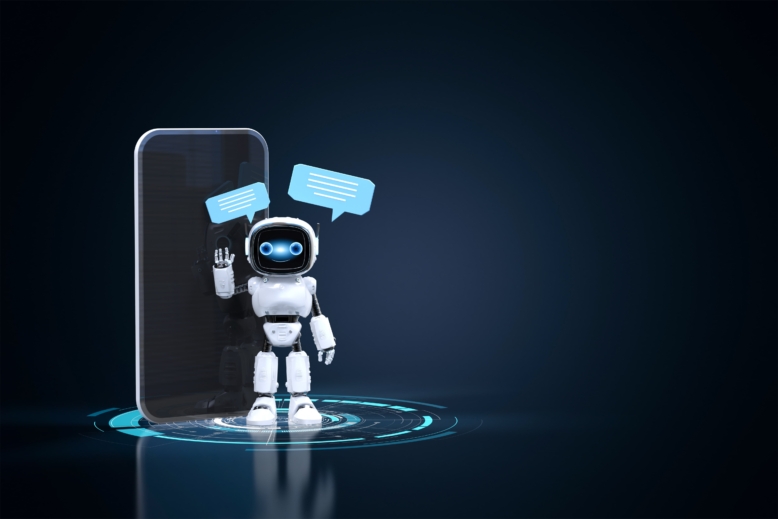Greetings! I'm Aneesh Sreedharan, CEO of 2Hats Logic Solutions. At 2Hats Logic Solutions, we are dedicated to providing technical expertise and resolving your concerns in the world of technology. Our blog page serves as a resource where we share insights and experiences, offering valuable perspectives on your queries.

Quick Summary
AI chatbots are transforming dropshipping by enhancing customer support, automating repetitive tasks, and improving engagement. They provide 24/7 assistance, handle FAQs, and boost efficiency, but they also have limitations, like a lack of empathy and struggles with complex queries.
A hybrid approach, combining AI chatbots with human agents, ensures a seamless customer experience. Implementing chatbots requires careful selection, training, and integration with existing systems, while success is measured through KPIs like customer satisfaction, response time, and cost savings.
That abandoned cart? It might have converted to sales if someone had been there to answer a simple shipping question.
That one-star review? It could have been avoided with a timely response to a tracking concern.
This is where the automation versus human support debate becomes critical. AI chatbots promise 24/7 availability and cost savings, while human agents offer the empathy and problem-solving skills that still can’t be matched.
But which approach is right for your dropshipping business? Or is the answer somewhere in between? This guide will cut through the hype and give you actionable insights on balancing AI efficiency with human touch in your customer service strategy.
Understanding AI Chatbots in Dropshipping
So, you’re running a dropshipping business and constantly dealing with customer inquiries? AI chatbots might be the solution you need.
What Are AI Chatbots?
AI chatbots are virtual assistants that automate customer interactions. They use natural language processing (NLP) and machine learning to understand queries and respond in real-time.
Unlike traditional support systems, chatbots don’t rely on pre-written scripts alone; they learn from interactions and improve over time.
How Chatbots Work in Customer Support
AI chatbots enhance customer support by automating repetitive tasks and providing instant responses. They can:
- Handling FAQs (shipping times, return policies, product details)
- Process order tracking requests automatically
- Offer product recommendations based on browsing history
- Route complex issues to human agents when needed
Pro Tip: The best chatbots feel conversational, not robotic. Adding a friendly tone and interactive buttons improves engagement.
Why Dropshipping Businesses Are Adopting Chatbots
Dropshipping is a high-volume, fast-moving business. Customers expect quick responses, and chatbots help businesses meet these demands efficiently.
- 24/7 Availability: AI chatbots respond instantly, no matter the time zone.
- Cost Reduction: Businesses save on hiring and training support staff.
- Scalability: It handles thousands of queries simultaneously without delays.
- Improved Customer Satisfaction: Faster responses lead to better shopping experiences.
Benefits of AI Chatbots in Dropshipping
AI chatbots are transforming the dropshipping industry by enhancing customer experience, automating support, and driving sales. Here’s why they are essential for modern dropshipping businesses:
- 24/7 Availability for Global Customers
Unlike human agents, chatbots operate around the clock, catering to customers in different time zones without delay. This ensures seamless support and higher satisfaction.
- Handling FAQs and Order Tracking Efficiently
AI-powered bots quickly answer common questions about shipping, returns, and product details. Customers get instant updates on their orders, reducing the need for manual support.
- Cost-Effective Automation for High-Volume Inquiries
By managing repetitive queries, chatbots reduce support costs and free up human agents for complex issues. This leads to improved efficiency and lower operational expenses.
- Consistency and Fast Response Times
Chatbots provide accurate and standardised responses in seconds. No more waiting for an agent; customers get immediate assistance, improving brand credibility.
- Lead Generation and Customer Engagement
AI chatbots personalise interactions, suggest relevant products, and capture leads. Engaging conversations convert visitors into buyers, boosting revenue for dropshipping businesses.
Pro Tip: Integrating chatbots with analytics tools help track customer behavior and optimise engagement strategies.
Limitations of AI Chatbots in Dropshipping
AI chatbots bring efficiency but have limitations that can impact customer satisfaction. Here’s where they fall short:
1. Lack of Emotional Intelligence and Empathy
AI chatbots follow programmed responses and lack human emotions. They struggle to understand frustration, urgency, or subtle nuances in a customer’s tone.
This can make interactions feel impersonal, especially when dealing with sensitive issues like refunds or complaints.
Example: A customer angrily complains about a delayed order, but the chatbot simply repeats tracking details instead of acknowledging their frustration.
2. Struggles with Complex Issues and Escalations
While chatbots handle FAQs well, they often fail when customers present unique problems requiring judgment and adaptability. Without human intuition, they may misinterpret requests or provide irrelevant responses.
Example: A customer needs to update their shipping address after placing an order, but the chatbot only provides a link to FAQs instead of offering real-time assistance.
3. Language Barriers and Contextual Misunderstandings
Even with multilingual capabilities, chatbots can struggle with slang, regional dialects, and complex sentence structures. They may misinterpret context, leading to incorrect responses.
Example: A chatbot misreads “I want a refund because my item didn’t fit” and responds with a return policy link instead of addressing the customer’s concern directly.
4. Potential Customer Frustration Due to Robotic Responses
When chatbots fail to resolve an issue, customers often feel stuck in an endless loop of automated replies. This leads to frustration, increased escalations, and negative reviews.
Example: A customer keeps selecting “speak to an agent,” but the chatbot repeatedly provides FAQ links, causing irritation and abandonment.
Takeaway: AI chatbots improve efficiency, but their limitations highlight the need for a hybrid approach, automating routine tasks while ensuring seamless handovers to human agents for complex cases.
The Human Element in Dropshipping Support
While AI chatbots enhance efficiency, human agents remain essential for delivering personalised and empathetic support. Here’s where human involvement makes a difference:
1. When Human Agents Are Necessary
Certain situations require human intuition and problem-solving skills that AI chatbots lack. Customers expect real conversations when dealing with complex or sensitive issues.
Example: A VIP customer requests a custom bulk order with specific shipping instructions; this requires human negotiation and coordination.
2. Empathy, Problem-Solving, and Personalized Service
Human agents can understand emotions, de-escalate conflicts, and offer tailored solutions beyond scripted responses. This is especially crucial for handling complaints and refunds.
Example: A customer receives a damaged product. Instead of an automated response, a human agent apologises, offers compensation, and ensures a quick replacement.
3. Challenges: Time Zones, Costs, and Scaling Issues
Hiring and managing a 24/7 human support team is expensive and challenging. Businesses must balance costs while ensuring quality service across different time zones.
Example: A dropshipping store with global customers struggles to provide live support in multiple languages without increasing operational costs.
4. Handling Refunds, Complaints, and High-Value Customers
Customers who spend large amounts expect premium service. Human agents provide reassurance, negotiate solutions, and build long-term relationships with high-value clients.
Example: A returning customer receives the wrong order. A human agent personally assists them, offering a discount and free express shipping for the replacement.
Finding the Right Balance: Hybrid Approach
A hybrid support system, combining AI chatbots with human agents, ensures efficiency while maintaining quality customer service.
| Aspect | AI Chatbots | Human Agents |
| Best Use Cases | FAQs, order tracking, basic inquiries, automated follow-ups | Disputes, refunds, high-value orders, emotional concerns |
| Escalation Pathways | Detects repeated queries and transfers to human support when necessary | Resolves complex issues that chatbots cannot handle |
| Efficiency vs. Personalization | Provides quick responses at scale, cost-effective | Delivers personalized support, builds customer trust |
Final Thought: AI chatbots and human agents work best together. By strategically integrating both, dropshipping businesses can optimise efficiency while delivering top-tier customer service.
Implementation Strategies
From handling customer inquiries to processing orders, a well-planned chatbot strategy can streamline operations and boost sales. But how do you implement AI effectively? Let’s dive in.
Choosing the Right Chatbot: Start by selecting a chatbot platform that aligns with your dropshipping needs. Look for solutions that support automation, multilingual capabilities, and seamless integration with e-commerce tools.
Training Chatbots: To improve accuracy, train your chatbot using real customer inquiries. Program it to handle FAQs, order tracking, and basic troubleshooting while allowing easy escalation to human agents.
System Integration: Ensure smooth functionality by integrating chatbots with your CRM, email, and order management systems. This helps streamline communication and improves efficiency.
AI-human Handoff: While chatbots can handle repetitive queries, complex customer issues require human intervention. Set up clear escalation pathways where AI can hand over conversations to a human agent when necessary.
To learn more about tools for dropshipping, continue reading.
Measuring Success: KPIs and ROI
Tracking key performance indicators (KPIs) and return on investment (ROI) helps businesses understand the impact of automation on customer experience, cost savings, and revenue growth. Let’s explore the essential metrics that define chatbot success.
| Metric | Why It’s Important | Example Target |
| Cost Saving | Compare chatbot expenses vs. human support costs | Reduce support costs by 30% |
| Response Time | Measures how quickly customers receive replies | Instant chatbot response, <1 min human response |
| Resolution Rate | Tracks how many issues chatbots solve effectively | 80% of FAQs handled by AI |
| Customer Satisfaction (CSAT) | Gauges user experience with chatbot interactions | Maintain a 90%+ CSAT score |
| Conversion Rate | Measure chatbot impact on sales | Boost conversions by 15% |
Conclusion
The debate between AI chatbots and human support isn’t about choosing one over the other, it’s about finding the right balance for your unique dropshipping business. The most successful approach combines automation for routine inquiries with human expertise for complex situations.
This is where 2Hats Logic comes in. We specialise in creating customised AI-human hybrid systems for dropshippers that analyse your specific customer service patterns and implement the optimal mix of automation and human support.
FAQ
How do AI chatbots help dropshipping businesses?
AI chatbots provide instant responses to customer queries, handle order tracking, and automate repetitive tasks, reducing support workload and improving efficiency.
Can AI chatbots fully replace human agents?
No, AI chatbots are great for handling FAQs and common inquiries, but human agents are necessary for complex issues, emotional support, and high-value customers.
Are chatbots cost-effective for small dropshipping businesses?
Yes, they reduce the need for a large customer support team, allowing small businesses to handle high volumes of inquiries efficiently.
What are the biggest challenges of using AI chatbots in dropshipping?
They struggle with emotional intelligence, complex queries, and language nuances, which can sometimes lead to customer frustration.
How can businesses measure chatbot success?
Key performance indicators (KPIs) include response time, resolution rate, customer satisfaction scores, and the impact on sales and support costs.

Related Articles






